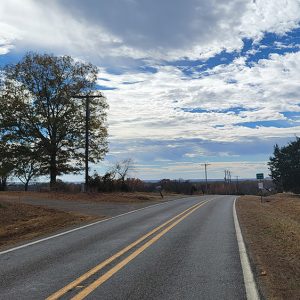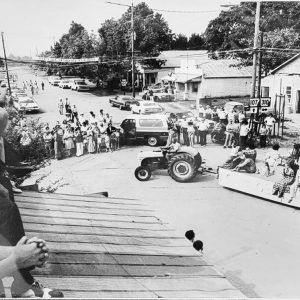calsfoundation@cals.org
Enola (Faulkner County)
| Latitude and Longitude: | 35°11’43″N 092°12’11″W |
| Elevation: | 318 feet |
| Area: | 2.71 square miles (2020 Census) |
| Population: | 318 (2020 Census) |
| Incorporation Date: | July 9, 1969 |
Historical Population as per the U.S. Census:
|
1810 |
1820 |
1830 |
1840 |
1850 |
1860 |
1870 |
1880 |
1890 |
1900 |
|
– |
– |
– |
– |
– |
– |
– |
– |
– |
– |
|
1910 |
1920 |
1930 |
1940 |
1950 |
1960 |
1970 |
1980 |
1990 |
2000 |
|
– |
– |
– |
– |
– |
– |
173 |
186 |
179 |
188 |
|
2010 |
2020 |
|
|
|
|
|
|
|
|
|
338 |
318 |
|
|
|
|
|
|
|
|
Enola is a small community twenty miles northeast of Conway (Faulkner County) at the intersection of Highway 36/107 and Highway 310. The town was established near a place called Fredrick’s Lick, a natural salt lick near Cadron Creek. The origin of its name is unknown, but local legend maintains that a lost traveler carved the word “alone” backward on a sign, producing “Enola.”
By 1837, Jonathon Hardin, one of the founders of Enola, had established his farm on a hill a half mile west of Fredrick’s Lick. He owned 3,000 acres of land, fifteen slaves, a coal mine, and a blacksmith’s shop. Hardin’s large house served as an inn at the intersection of the Lewisburg–Searcy, Des Arc–Springfield, and Little Rock–Clinton roads.
Mount Zion Baptist Church was built in the late 1840s (some sources say 1867). It served as the town’s first schoolhouse, as well as a Masonic Lodge, Enola Lodge No. 124. Enola hosted the first chapter of the Eastern Star in Arkansas until it surrendered its charter in 1886 due to lack of attendance. Other denominations, such as Methodist and Church of Christ, also established their own churches in the town.
During the Civil War, many farmers from Enola joined Company E of the Tenth Arkansas Infantry (Confederate). This unit—originally under the command of Colonel Thomas E. Merrick, a farmer, merchant, and former mayor of Little Rock (Pulaski County)—participated in the Battle of Shiloh in 1862 and the failed Confederate defense of Port Hudson, Louisiana, in 1863. The unit was later reconstituted as a Confederate cavalry guerrilla unit under the command of Colonel Allen R. Witt. From 1863 to 1865, it roamed throughout northern Arkansas, Missouri, and Kansas engaging Union forces with little success.
Other residents of Enola, such as George Washington Dalton, joined the Union’s Third Arkansas Cavalry. After the war, Dalton became a teacher, ordained minister, farmer, and writer. He died in 1940 and was the last surviving Union soldier of Faulkner County. Dr. Bill Hinkle, a state representative and Conway County clerk, served as a Union army captain during the war.
Historian John Hugh Reynolds was born near Enola in 1869. He served as a professor and president at Hendrix College and helped establish the Arkansas Historical Association and the Arkansas History Commission (now called the Arkansas State Archives). He died in 1954.
In 1867, a road was established through Enola connecting Little Rock and Quitman (Cleburne County). In 1872, under the auspices of the state Grange, a second lodge, Enola Lodge 141, was opened in nearby Mount Vernon (Faulkner County). Enola’s first post office was established in 1879, with Stephen E. Lorniar (other sources say Steven E. Lamar) as its first postmaster. In 1881, a school was built in Enola; it later burned down. In 1915, the Church of Jesus Christ of Latter-day Saints established a church in Enola.
Beginning in the 1930s, smaller surrounding rural school districts began to consolidate with Enola. In 1938–39, the Enola School was constructed. Additional buildings were added in 1973. The town of Enola was incorporated on July 9, 1969.
In 1991, the Mount Vernon and Enola school districts consolidated to form the Mount Vernon/Enola School District. The Enola School became Mount Vernon/Enola Elementary, which serves kindergarten through sixth-grade students. Mount Vernon/Enola High School in Mount Vernon (originally constructed in 1937, with additions in 1973, 1983, and 1986) serves students in grades seven through twelve.
Today, Enola is a small farming community producing soybeans, rice, wheat, sorghum, and livestock. There are a number of small businesses in the area, including building contractors and trucking firms. Many people in Enola commute to Conway and Little Rock to work.
For additional information:
Dalton, George Washington. “Early Days in Enola.” Faulkner Facts and Fiddlings 29 (Spring/Summer 1987): 25–26.
Faulkner County Historical Society. Faulkner County: Its Land and People. Conway, AR: Faulkner County Historical Society, 1986.
Ingram, Dibrell. “People around Enola, Arkansas—1830–1880.” Faulkner Facts and Fiddlings 19 (Summer 1977): 23–44.
Aaron W. Rogers
Conway, Arkansas
 Entering Enola
Entering Enola  Enola
Enola  Enola Community Center
Enola Community Center  Enola Fire Department
Enola Fire Department  Enola Parade
Enola Parade  Enola Post Office
Enola Post Office  Enola School
Enola School  Enola Street Scene
Enola Street Scene  Enola Street Scene
Enola Street Scene  Enola/Mount Vernon Water Tower
Enola/Mount Vernon Water Tower  Faulkner County Map
Faulkner County Map  Enola High Graduation Program
Enola High Graduation Program  Mt. Zion Missionary Baptist
Mt. Zion Missionary Baptist  Old Enola Post Office
Old Enola Post Office 



Comments
No comments on this entry yet.